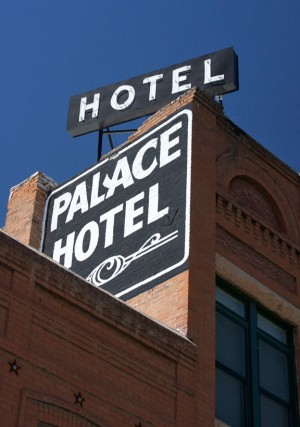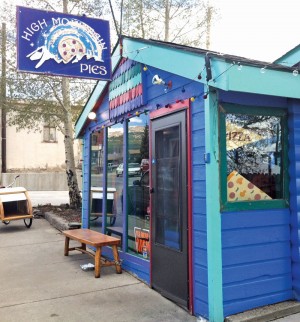By Martha Quillen
I’ve always thought of Salida as a sweet, old-fashioned sort of place with picturesque houses, tree-lined streets and a bandstand in the park. To me it seems a lot like River City, the fictionalized Iowa town in The Music Man.
Many Colorado towns, including Salida, exude some of River City’s charm, but our history is somewhat grittier than our current exterior suggests. Salida was a regional rail center in 1912 and still housed a notorious red-light district. And its inhabitants included a myriad of work-roughened laborers, immigrants and transients who manned the local mines, quarries, ranches and rail yards. In those days, Central Colorado was no stranger to conflict or violence.
The Music Man gives an impression of a lovely little town, but not a comprehensive portrait, which makes one wonder: would a deeper inspection make River City seem more like Hadleyburg? Or Sunnydale? Who really lived in rural America then?
And who lives here now? I only ask because Salida’s politics and the 2016 national campaigns are exposing how contradictory citizens’ impressions and viewpoints can be.
A recent U.S. News and World Report post called Why We Should Have Seen the Rise of Donald Trump Coming in 7 Graphs, by Lindsay Cook reveals substantial perceptual differences. Asked how they feel about the Federal government, a mere one percent of Trump supporters said they were basically content while 50 percent said they were angry. But respondents for Clinton were 34 percent content and 6 percent angry, while for Sanders, 21 percent were content and 13 percent were angry.
Another graph shows that 60 percent of “white working class” respondents believe that “discrimination against whites has become as big a problem as discrimination against blacks and other minorities,” whereas only 39 percent of “white college-educated” respondents agree.
(As an aside, I can’t help but question those categories. In Salida, a high percentage of our white working class is college-educated. So, is there a region where college-educated people don’t wait tables?)
Cook delivers lots of other observations about perceptual differences (with numerous links to full-text articles). For example, in terms of racial inequality, she reports that “plenty of white people in the U.S. weren’t buying that there was a big problem, nor have they shared African-Americans’ suspicion of police officers or law enforcement tactics.”
Cook’s sources also include official stats, but the gaping differences in peoples’ perceptions about current issues may be more relevant. To illustrate why, let’s go back to that long-ago era so frequently portrayed as being peopled with parasol-wielding women and barbershop quartets prone to bursting out in spontaneous harmony.
[InContentAdTwo]
After the 1893 silver panic, numerous mines shut, and mine owners decided they could recoup their losses by instituting longer hours for the same daily wages. But the unions pushed back.
In Cripple Creek, mine owners geared up for a protracted fight by amassing a private army and paying the sheriff to hire deputies. An armed battle ensued, but Colorado Governor Davis Waite intervened, “in one of the few cases in which a state government proved sympathetic to striking miners,” according to historian Richard White.
And thus an eight-hour day was established – for a time. It was a major victory for the Western Federation of Miners (WFM), which led to high union membership and the formation of dozens of locals.
But the WFM didn’t merely want to improve the working, living and safety conditions offered by the mining industry. It also wanted to reduce the power of capitalists.
Human life and labor came cheap in that era. The mines were not only unsafe, many of them paid in script that could only be spent in company towns. So the WFM built hospitals and offered aid – for sick and injured members, and for widows, orphans, and even the dead (when burial was needed) in order to reduce its members’ reliance on their bosses. And for a time, the WFM and Cripple Creek prospered.
But in 1903, mill and smelter workers tried to organize, and the underground miners of Cripple Creek supported them. Miners were fired, and a strike was called. This time around, however, Governor J.H. Peabody sided firmly with the owners.
In 1904, an accident at the Independence Mine killed 15 men, and a coroner’s jury concluded the deaths were due to equipment failure caused by owner negligence. But the mine owners claimed union members had sabotaged their equipment. (As for who actually did what? That’s still being argued.)
Then a railroad depot was dynamited, killing 13 non-union miners, and mayhem ensued. The Mine Owners Association and state militia joined with a citizens’ alliance and forced Sheriff Robertson to resign under threat of lynching. Afterward, they gathered for a rousing speech to blame the WFM for the depot killings. But a sudden movement in the crowd panicked the assemblage and a gun battle resulted, killing two men, whereupon the citizens went on a rampage, wrecking union halls, looting union stores, and shooting union members.
It was the end for the WFM in Cripple Creek, and the beginning of the end for the Citizens Alliance, which was composed of businessmen who were convinced things would be better without the union’s radical notions. But lower-paid workers led to less business, and the “merchants of town relearned too late that they indeed lived not off the mines but off the miners,” as White concluded in It’s Your Misfortune and None of My Own.
But Cripple Creek’s woes were merely an episode in a continuing series of labor problems. On April 20, 1914 (during the 1913-1914 strikes known as the Colorado Coalfield War), miners at Ludlow faced down 177 militia and two machine guns, and their tent city caught on fire. Later The New York Times reported, “In the holes which had been dug for their protection against the rifle’s fire, the women and children died like trapped rats when the flames swept over them.”
As for what really caused all this strife, Ethelbert Stewart, a Federal investigator summed up the problem in 1913:
“… Theoretically, perhaps, the case of having nothing to do in this world but work, ought to have made these men of many tongues, as happy and contented as the managers claim … To have a house assigned you to live in … to have a store furnished you by your employer … to have churches, schools … and public halls free for you to use for any purpose except to discuss politics, religion, trade-unionism or industrial conditions; in other words, to have everything handed down to you from the top; to be … prohibited from having any thought, voice or care in life but work … That men have rebelled grows out of the fact that they are men.”
Labor issues inspired another tragic reaction. By the 1920s, anti-immigrant sentiment peaked and men in white hoods were parading down Colorado’s main streets. The Klan’s aim in Colorado was not to harass former slaves but to intimidate immigrant workers who were thought to be “stealing” jobs and lowering wages.
And so we come full circle. In 2016, the Klan is once again intruding into politics, and citizens – be they white, black, ethnic, poor, or from small towns or big metropolises – are resentful, divided, and inclined to see their political opponents as unreasonable troublemakers.
Economic decline likely incites such resentment, but our hostility is about more than money. As Ethelbert Stewart’s assessment suggests, money merely provides people with the means to provide food, shelter and opportunities for themselves and their families – and thereby maintain some measure of dignity and self-respect. g
Martha Quillen regrets that she didn’t have room to include information about mining conditions, Harry Orchard, Rockefeller, unions and all of the fascinating history websites available.


